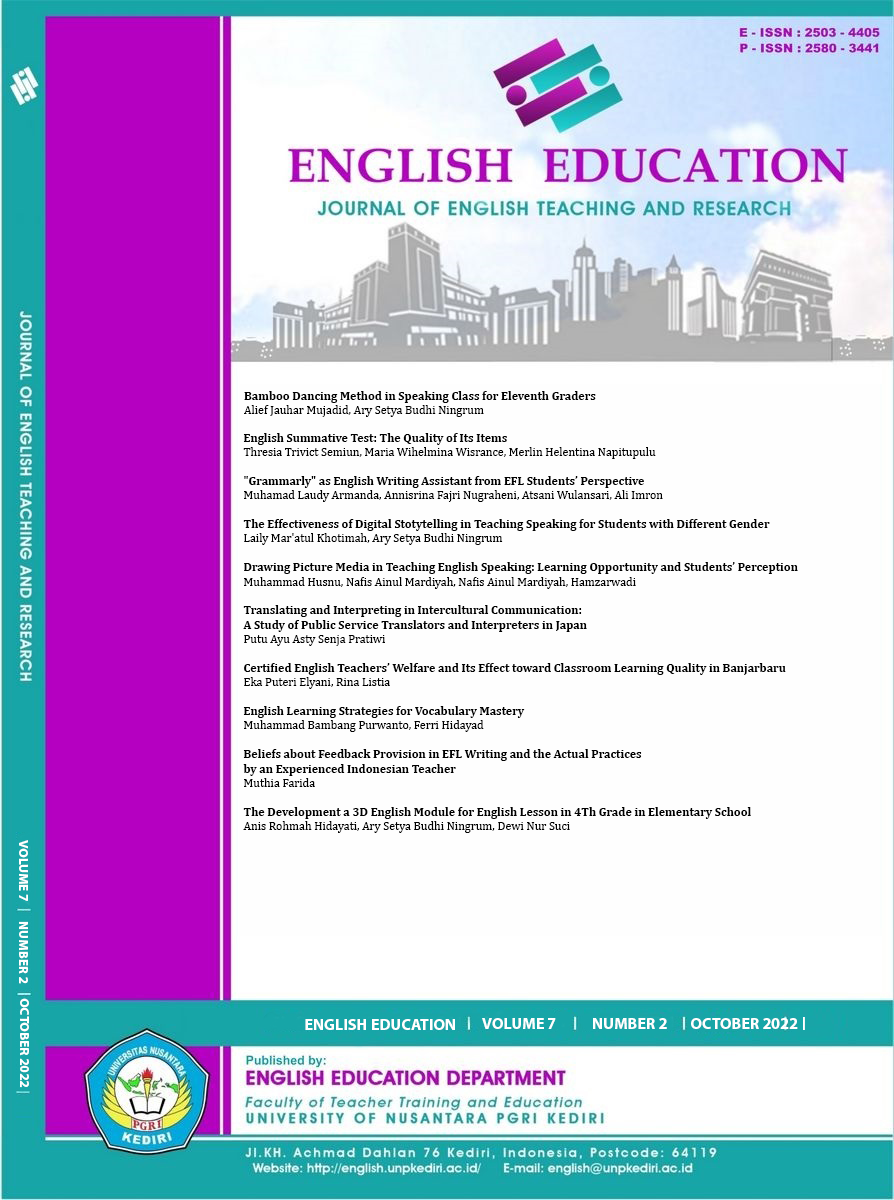Drawing Picture Media in Teaching English Speaking: Learning Opportunity and Students’ Perception
DOI:
https://doi.org/10.29407/jetar.v7i2.18343Keywords:
drawing picture media, learning opportunities, students' perceptionAbstract
The purpose of this study was to clarify and investigate the effect of Drawing Picture Media on improving the students’ speaking skills and their responses to the use of picture media in Indonesian EFL classrooms. In this case, the researcher used quantitative and qualitative research methods. Quantitatively, the data was collected by using a pre-experimental design, with a treatment to the One Group Pretest-Posttest group. Before the researcher gave treatment, the average score of students was 11.13, then increased to 15.13 after the treatment. Therefore, learning using the Drawing Picture Media method significantly improves students' speaking skills. The results of data analysis using observations and questionnaires showed that most of the students (83%) responded very well to the drawing picture media that was used in learning English in the classroom. From these results, the researcher can conclude that students' perceptions of the learning media were excellent.
Downloads
References
Dawamuddin, Y. (2021). the Effectiveness of Teaching Vocabulary By Using Picture Media Toward Students’ Speaking Ability At Eighth Grade Students of Smp It Al Asror Sekampung. Journal of English Development, 1(1), 53–61. https://doi.org/10.25217/jed.v1i01.1424
Harmer, J. (2007). How to teach English. Ocelot Publishing.
Kosdian, O. (2017). Improving Students� Speaking Skill By Using Picture Strip Story. Indonesian EFL Journal, 2(2), 100. https://doi.org/10.25134/ieflj.v2i2.642
Mumtahabah, N. (2014). Penggunaan Media Dalam Pembelajaran. AL HIKMAH Jurnal Studi Keislaman, Volume 4, Nomor 1, Maret 2014, 4(1), 2–14.
Neuman, W. R. (2010). Media, Technology, and Society: Theories of Media Evolution (W. R. Neuman (ed.); illustrate). Digital Culture Books/University of Michigan Press.
Nur, N. A. (2018). Describing and Drawing Picture Technique in Teaching Transactional Speaking. ETERNAL (English, Teaching, Learning, and Research Journal), 4(2), 268. https://doi.org/10.24252/eternal.v42.2018.a10
Prasetyaningrum, A. (2017). The Use of Puppets in Teaching Speaking for Junior High School Students. VELES Voices of English Language Education Society, 1(2), 48–57. https://doi.org/10.29408/veles.v1i2.446
Pratiwi, S., Purwanti, S. E., & Mustajib, A. (2021). THE EFFECT DESCRIBE AND DRAW TECHNIQUE TOWARD STUDENTS ’ SPEAKING SKILL. 3(1), 55–64.
Ristyani, N. A., & Nurhayati, N. N. (2020). Improving Students’ Interest By Using Picture Media At Tk Nur Assalam. PROJECT (Professional Journal of English Education), 3(1), 1. https://doi.org/10.22460/project.v3i1.p1-4
Santoso, D. A. A., Muniroh, Z., & Akmaliah, N. (2019). Pengaruh Penggunaan Media Gambar Terhadap Keterampilan Berbicara Bahasa Inggris. KREDO : Jurnal Ilmiah Bahasa Dan Sastra, 2(2), 181–194. https://doi.org/10.24176/kredo.v2i2.2827
Simamora, J. M., Sembiring, N., & Pangaribuan, J. J. (2020). Improving Studentsâ€TM Speaking Skills By Using Picture-Cued Media To the Eighth Grade Students of Smp Santo Yoseph Medan. Kairos English Language Teaching Journal, 2(2), 111–127. https://doi.org/10.54367/kairos.v2i2.728
Sulastri, N. (2011). The effectiveness of picture chart media on students’ English vocabulary. Journal on English as a Foreign Language, 1(2), 103. https://doi.org/10.23971/jefl.v1i2.195
Turnip, E. C., Purba, A. P., & Sitompul, E. N. (2020). The Effect of using Picture Strip Story on Students’ Speaking Skill. Linguistic, English Education and Art (LEEA) Journal, 3(2), 308–315. https://doi.org/10.31539/leea.v3i2.1015
Yusnita, E., Sada, C., Novita, D., Education, E., Program, S., Training, T., & Faculty, E. (2012). A Classroom Action Research to the Tenth Grade Students of. English Education Study Program, Teacher Training and Education Faculty of Tanjungpura University, 2(1), 1–14.
Downloads
Published
Issue
Section
License
Authors who publish with this journal agree to the following terms:
- Copyright on any article is retained by the author(s).
- The author grants the journal, the right of first publication with the work simultaneously licensed under a Creative Commons Attribution License that allows others to share the work with an acknowledgment of the work’s authorship and initial publication in this journal.
- Authors are able to enter into separate, additional contractual arrangements for the non-exclusive distribution of the journal’s published version of the work (e.g., post it to an institutional repository or publish it in a book), with an acknowledgment of its initial publication in this journal.
- Authors are permitted and encouraged to post their work online (e.g., in institutional repositories or on their website) prior to and during the submission process, as it can lead to productive exchanges, as well as earlier and greater citation of published work.
- The article and any associated published material is distributed under the Creative Commons Attribution-ShareAlike 4.0 International License








 Article template
Article template



